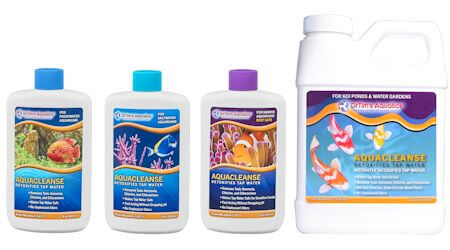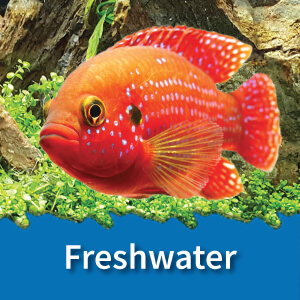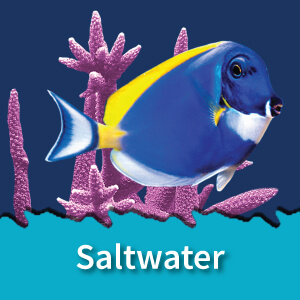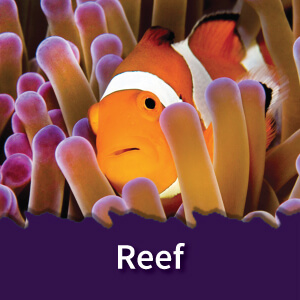Remove Toxic Chemicals in Your Tank
Use DrTim’s AquaCleanse Tapwater Detoxifier During Routine Water Changes
Use AquaCleanse Tapwater Detoxifier to:
- Eliminate common chemicals in tapwater
- Remove chlorine, chloramines and ammonia
- Instantly detoxify tap water
- Dextoxify water with no odor
Most tap water contains considerable amounts of chlorine, chloramines and/or ammonia. These chemicals make the water safe to drink by preventing micro-organisms from growing in the drinking water. But these chemicals are toxic to fish, corals and other invertebrates and must be removed before placing animals in your aquarium.
Unlike some products that only mask these chemicals AquaCleanse destroys them – completely removing these harmful chemicals from the water with no unpleasant odor!
Helpful Videos
Subscribe to DrTim’s YouTube Channel for More Informative Videos
Using an Ammonia Remover/Dechlorinator
Overdosing ammonia removers during the start-up and break-in cycle of a newly set-up aquarium can cause problems and actually delay the onset of nitrification, even when using a culture of living nitrifying bacteria.
Before adding nitrifying bacteria to their newly set-up aquarium, many people add a dechlorination/ammonia removing agent to their tap water to get rid of any chlorine, chloramines and ammonia that may be present. This is a good practice, but it can lead to problems when the product is overdosed.
Overdosing many of the ammonia removing products on the market will actually inhibit the nitrifying bacteria from growing and becoming established in the new tank. So in reality, by adding more and more ammonia remover to the aquaria, you are actually doing more harm than good and delaying the establishment of your bio-filter.
The best way to use an ammonia-removing product is to follow the dosing directions – don’t just pour “some” into the tank, as this can lead to overdosing. Use the product when you first set up the tank, and if you see an increasing amount of ammonia in the water, it is better to do a partial water change than to pour more and more ammonia remover in the water.
Also, if you decided not to add a culture of living nitrifying bacteria to your system when you started, it is not good to add the bacteria later when there is already a high concentration of ammonia in the water. The best way forward is to change some of the water to get the ammonia concentration down below 2 mg/L-N (2 ppm-N), and then add the bacteria, but do not add more ammonia remover.
Why do ammonia removers inhibit the nitrifying bacteria?
There are two major reasons for this and both may apply to your aquarium.
First, many ammonia removers are acids, so repeatedly adding them to the aquarium water will cause the pH to drop. This in turn means that the ammonia is in the ionized form (NH4+), which is the form the nitrifying bacteria CANNOT use. So the amount of ammonia converted to nitrite is less per day than if the pH were higher.
Second, some of the products have a chemical in them that inhibits the bacteria when the chemical is in a higher concentration, which occurs when the product is overdosed.
If your newly set-up tank is having problems cycling, consider how much ammonia remover you have been using; you may be overdosing and need to cut back.
DrTim’s Aquatics AquaCleanse is safe to use with our One & Only Live Nitrifying Bacteria.
In conclusion, using an ammonia remover can be a benefit when first setting up your aquarium, but relying on it to control ammonia during the start-up cycle, instead of water changes or using a live nitrifying bacteria mix, can be a mistake.
Using an Ammonia Remover/Dechlorinator
Overdosing ammonia removers during the start-up and break-in cycle of a newly set-up aquarium can cause problems and actually delay the onset of nitrification, even when using a culture of living nitrifying bacteria.
Before adding nitrifying bacteria to their newly set-up aquarium, many people add a dechlorination/ammonia removing agent to their tap water to get rid of any chlorine, chloramines and ammonia that may be present. This is a good practice, but it can lead to problems when the product is overdosed.
Overdosing many of the ammonia removing products on the market will actually inhibit the nitrifying bacteria from growing and becoming established in the new tank. So in reality, by adding more and more ammonia remover to the aquaria, you are actually doing more harm than good and delaying the establishment of your bio-filter.
The best way to use an ammonia-removing product is to follow the dosing directions – don’t just pour “some” into the tank, as this can lead to overdosing. Use the product when you first set up the tank, and if you see an increasing amount of ammonia in the water, it is better to do a partial water change than to pour more and more ammonia remover in the water.
Also, if you decided not to add a culture of living nitrifying bacteria to your system when you started, it is not good to add the bacteria later when there is already a high concentration of ammonia in the water. The best way forward is to change some of the water to get the ammonia concentration down below 2 mg/L-N (2 ppm-N), and then add the bacteria, but do not add more ammonia remover.
Why do ammonia removers inhibit the nitrifying bacteria? There are two major reasons for this and both may apply to your aquarium.
First, many ammonia removers are acids, so repeatedly adding them to the aquarium water will cause the pH to drop. This in turn means that the ammonia is in the ionized form (NH4+), which is the form the nitrifying bacteria CANNOT use. So the amount of ammonia converted to nitrite is less per day than if the pH were higher.
Second, some of the products have a chemical in them that inhibits the bacteria when the chemical is in a higher concentration, which occurs when the product is overdosed.
If your newly set-up tank is having problems cycling, consider how much ammonia remover you have been using; you may be overdosing and need to cut back.
DrTim’s Aquatics AquaCleanse is safe to use with our One & Only Live Nitrifying Bacteria.
In conclusion, using an ammonia remover can be a benefit when first setting up your aquarium, but relying on it to control ammonia during the start-up cycle, instead of water changes or using a live nitrifying bacteria mix, can be a mistake.







 Yes, there really is a Dr. Tim. It all started with 2 goldfish won at a school fair at age 6 that didn’t survive their first night in his care. DrTim’s gotten better at fish keeping since then! Read Our Story.
Yes, there really is a Dr. Tim. It all started with 2 goldfish won at a school fair at age 6 that didn’t survive their first night in his care. DrTim’s gotten better at fish keeping since then! Read Our Story.